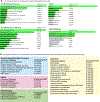Vasa, a regulator of localized mRNA translation on the spindle
- PMID: 36825672
- PMCID: PMC10023503
- DOI: 10.1002/bies.202300004
Vasa, a regulator of localized mRNA translation on the spindle
Abstract
Localized mRNA translation is a biological process that allows mRNA to be translated on-site, which is proposed to provide fine control in protein regulation, both spatially and temporally within a cell. We recently reported that Vasa, an RNA-helicase, is a promising factor that appears to regulate this process on the spindle during the embryonic development of the sea urchin, yet the detailed roles and functional mechanisms of Vasa in this process are still largely unknown. In this review article, to elucidate these remaining questions, we first summarize the prior knowledge and our recent findings in the area of Vasa research and further discuss how Vasa may function in localized mRNA translation, contributing to efficient protein regulation during rapid embryogenesis and cancer cell regulation.
Keywords: DDX4; Vasa; asymmetric cell division; embryonic cells; localized translation; sea urchin; spindle.
© 2023 Wiley Periodicals LLC.
Conflict of interest statement
CONFLICT OF INTEREST
The authors declare no conflict of interest.
Figures





Similar articles
-
Vasa nucleates asymmetric translation along the mitotic spindle during unequal cell divisions.Nat Commun. 2022 Apr 20;13(1):2145. doi: 10.1038/s41467-022-29855-8. Nat Commun. 2022. PMID: 35444184 Free PMC article.
-
Essential elements for translation: the germline factor Vasa functions broadly in somatic cells.Development. 2015 Jun 1;142(11):1960-70. doi: 10.1242/dev.118448. Epub 2015 May 14. Development. 2015. PMID: 25977366 Free PMC article.
-
The DEAD-box RNA helicase Vasa functions in embryonic mitotic progression in the sea urchin.Development. 2011 Jun;138(11):2217-22. doi: 10.1242/dev.065052. Epub 2011 Apr 27. Development. 2011. PMID: 21525076 Free PMC article.
-
An unregulated regulator: Vasa expression in the development of somatic cells and in tumorigenesis.Dev Biol. 2016 Jul 1;415(1):24-32. doi: 10.1016/j.ydbio.2016.05.012. Epub 2016 May 11. Dev Biol. 2016. PMID: 27179696 Free PMC article. Review.
-
Controlling the Messenger: Regulated Translation of Maternal mRNAs in Xenopus laevis Development.Adv Exp Med Biol. 2017;953:49-82. doi: 10.1007/978-3-319-46095-6_2. Adv Exp Med Biol. 2017. PMID: 27975270 Free PMC article. Review.
Cited by
-
Single-cell proteomics reveals decreased abundance of proteostasis and meiosis proteins in advanced maternal age oocytes.Mol Hum Reprod. 2024 Jun 26;30(7):gaae023. doi: 10.1093/molehr/gaae023. Mol Hum Reprod. 2024. PMID: 38870523 Free PMC article.
-
Characteristics of the Vasa Gene in Silurus asotus and Its Expression Response to Letrozole Treatment.Genes (Basel). 2024 Jun 8;15(6):756. doi: 10.3390/genes15060756. Genes (Basel). 2024. PMID: 38927693 Free PMC article.
References
Publication types
MeSH terms
Substances
Grants and funding
LinkOut - more resources
Full Text Sources
Miscellaneous

